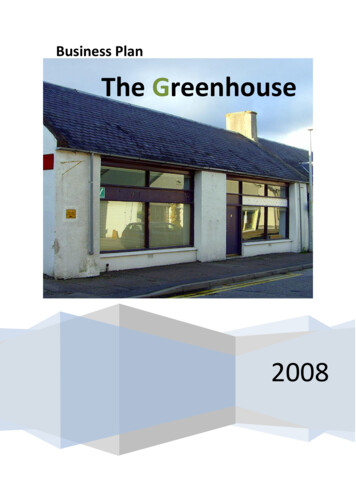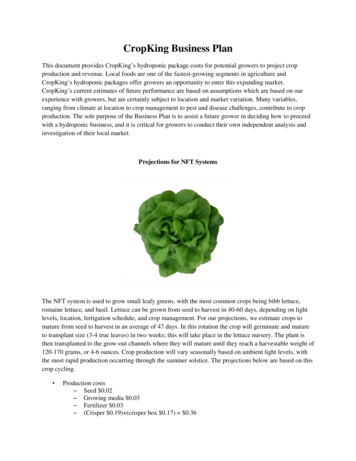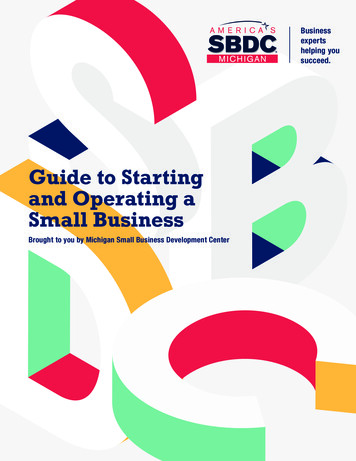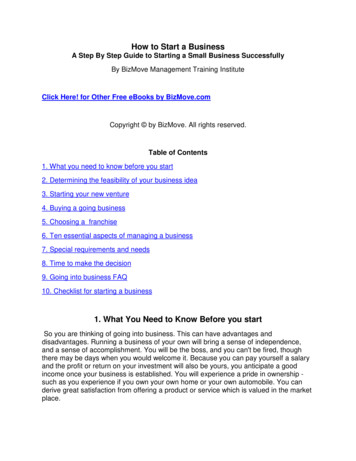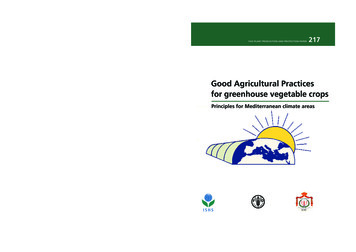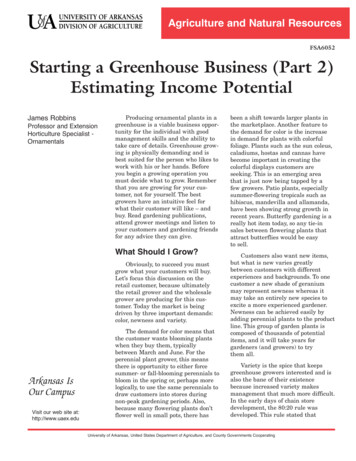
Transcription
Agriculture and Natural ResourcesFSA6052Starting a Greenhouse Business (Part 2)Estimating Income PotentialJames RobbinsProfessor and ExtensionHorticulture Specialist OrnamentalsProducing ornamental plants in agreenhouse is a viable business oppor tunity for the individual with goodmanagement skills and the ability totake care of details. Greenhouse grow ing is physically demanding and isbest suited for the person who likes towork with his or her hands. Beforeyou begin a growing operation youmust decide what to grow. Rememberthat you are growing for your cus tomer, not for yourself. The bestgrowers have an intuitive feel forwhat their customer will like – andbuy. Read gardening publications,attend grower meetings and listen toyour customers and gardening friendsfor any advice they can give.What Should I Grow?Obviously, to succeed you mustgrow what your customers will buy.Let’s focus this discussion on theretail customer, because ultimatelythe retail grower and the wholesalegrower are producing for this cus tomer. Today the market is beingdriven by three important demands:color, newness and variety.Arkansas IsOur CampusVisit our web site at:http://www.uaex.eduThe demand for color means thatthe customer wants blooming plantswhen they buy them, typicallybetween March and June. For theperennial plant grower, this meansthere is opportunity to either forcesummer- or fall-blooming perennials tobloom in the spring or, perhaps morelogically, to use the same perennials todraw customers into stores duringnon-peak gardening periods. Also,because many flowering plants don’tflower well in small pots, there hasbeen a shift towards larger plants inthe marketplace. Another feature tothe demand for color is the increasein demand for plants with colorfulfoliage. Plants such as the sun coleus,caladiums, hostas and cannas havebecome important in creating thecolorful displays customers areseeking. This is an emerging areathat is just now being tapped by afew growers. Patio plants, especiallysummer-flowering tropicals such ashibiscus, mandevilla and allamanda,have been showing strong growth inrecent years. Butterfly gardening is areally hot item today, so any tie-insales between flowering plants thatattract butterflies would be easyto sell.Customers also want new items,but what is new varies greatlybetween customers with differentexperiences and backgrounds. To onecustomer a new shade of geraniummay represent newness whereas itmay take an entirely new species toexcite a more experienced gardener.Newness can be achieved easily byadding perennial plants to the productline. This group of garden plants iscomposed of thousands of potentialitems, and it will take years forgardeners (and growers) to trythem all.Variety is the spice that keepsgreenhouse growers interested and isalso the bane of their existencebecause increased variety makesmanagement that much more difficult.In the early days of chain storedevelopment, the 80:20 rule wasdeveloped. This rule stated thatUniversity of Arkansas, United States Department of Agriculture, and County Governments Cooperating
80 percent of your sales came from 20 percent of yourproduct. This means there are certain must-haveitems in any greenhouse operation. Table 1 attemptsto list the most important items.Table 1. Items that are high volume plants and important inevery greenhouse operation.Bedding Plants: Geraniums (4-inch) Impatiens (multiple cultivars to create the look of diversity) Petunias (new Wave series and Surfina are strong growers) Salvia (reds 80%, mixed other colors) Pansies (many types for autumn sales) Begonias (seem to be declining in importance) Coleus (Sun coleus types) Caladiums (4- or 6-inch pots) Tomatoes (the only high-volume vegetable bedding plant) Peppers Lantana (rapidly emerging cutting-grown plant for 4-inchsales, potential for larger plants) New Guinea impatiens (4- or 6-inch items)Perennials: Hosta (a mixture of the better older selections and the new,higher-priced items) Daylilies (the reblooming types akin to ʻStella DʼOroʼ havereinvented this old perennial) Bleeding heart (while old, it is new to a surprising number ofgardeners) Assorted ornamental grasses Any assorted perennials that bloom during peak customertraffic periodsHanging Baskets: Boston ferns Impatiens baskets Lantana baskets Wave petunia basketsPot Plants: Geraniums (6-inch) (red/orange 80%, pinks 15%, white 5%) Garden mums (premium quality for fall sales) Poinsettias (some growers choose to close in the fall toavoid this crop)The items given in Table 1 only represent the mostcommon greenhouse crops. Variety can be achieved bygrowing several cultivars of the same species, thussimplifying the growing operation. Every greenhousein Arkansas will have the items listed above, but whatmakes most retail greenhouse operations different iswhat is chosen for the 80 percent of the items thatproduce 20 percent of the sales. Some operationschoose to really promote their diversity while othersdownplay this aspect of the business. Greenhousesupply company salespeople can help fill in the gapsto provide a diverse and compatible product mix whichwill keep the attention of customers. But, the green house manager must take an active part in selectingthis product line to ensure its success.How Do I Schedule the Crops?Timing greenhouse production starts by decidingwhen you want the crop to be ready and then workingbackwards to determine the planting date. This processis aided greatly by the use of the week number system.In this system, the first week in the year is week 1,the last week is week 52. Many greenhouse crops aregrown through the late summer and fall into thefollowing spring and summer. Therefore, it is morepractical to look at the week numbers from week 30(the end of July) until week 52 and then week 1 backto week 30. For example, fern baskets might be startedin week 40 and finished the next spring during week10 for a total production time of 22 weeks. A basketitem like a Boston fern is grown with no photoperiodiccontrol – it simply takes time for the crop to grow tosufficient size to be salable.Flowering plants can be scheduled to bloom atany season using week numbers. Rooted poinsettiacuttings are usually planted around week 36 andfinished around week 47 for 11 weeks of productiontime. Poinsettias are a short day crop that initiatesflower buds around September 20 as the days getshorter than 12 hours. Chrysanthemums can likewisebe induced to bloom at any season by using photo period to trick the crop into blooming. For example,let’s suppose we wanted a crop of chrysanthemums tobloom during week 30. Chrysanthemum cultivars arecategorized into differing response groups, usuallyfrom 7 weeks for garden mums to 9 weeks for most potmums to 10 or 11 weeks for cut mums. The responsegroup is the weeks from the start of short days untilflowering. So, using a 9-week response group, we nowknow that we would need to start short days onweek 21. But, we can’t just pop the cutting in a pot andstart short days. We have to grow the plant some firstunder long-day conditions. With mums, plants aregrown 1 week under long days after the pinch, so wewould pinch on week 20. The cuttings are grown1 week before pinching to establish the cutting; there fore, we would plant on week 19. A typical productionschedule for a pot mum crop is shown in Table 2.Table 2. A typical pot mum production schedule using theweek scheduling method.Week192021222324252627282930Taskpot plantspinchbegin short dayscare as neededcare as neededcare as neededcare as neededdisbud or use center bud removalcare as neededcare as neededstop fertilization, leachplants in flower
With this simple scheduling device it is possible toplan the use of your greenhouse space (Table 3). A com puter spreadsheet such as Excel or Quattro Pro willspeed this process and help organize the schedule andmake sure the greenhouse space is used efficiently.Begin by numbering the left-hand column from 30 to52 and then 1 to 29 to represent weeks from July 1until the last week of the following June. In the secondcolumn, fill the entire column with the square footageavailable for growing crops.Each crop which is planned to finish on a specificdate in a different size container will need threecolumns. In the first column, list the number of unitsyou would produce, in the second list the squarefootage per unit, and in the third record specific tasksthat would need doing. Begin by deciding when eachcrop will be finished and count backward to the varioustasks that need doing. For example, say you plan togrow a crop of 3,000 bedding plant flats (a 5-week cropfrom plugs) with 36 plants per flat and you plan togrow your own plugs using the 288 plug flat (a 4-weekcrop). You will also have 250 flats of tomatoes (a6-week crop from seed) and 2,500 geraniums in 6-inchpots on 10-inch centers. Look at the schedule anddetermine the sales date and production steps for eachcrop. Use the built-in formulas of the spreadsheet tomake the needed calculations. During weeks 12 and 13we still have 275 sq. ft. of space available.How Much Money Will a GreenhouseGenerate?The secret to making money in a greenhouse isto produce and sell your crops at a profit. To do thisyou must be able to calculate the cost of production.Costs fall into two broad categories: indirect costsand direct costs. Indirect costs, also called over head or fixed costs, are those reoccurring coststhat accrue even if the greenhouse is not beingused. They include those costs that are difficultto assign to a given crop but should logically beadded to all crops produced during the year.Typically, indirect cost items include things suchas depreciation, interest, management expenses,production wages (unless they can be assigned toa specific crop), property taxes, utility costs, etc.Table 4 shows indirect costs for a greenhouse with6,800 square feet of production space and computesthe total indirect cost for each of three possibleproduction scenarios.Once total indirect costs are calculated, thosecosts must be prorated to each individual crop sothat these overhead costs are reflected in the actualcost of each crop. The method used to assign theindirect costs to a crop requires the calculation ofthe total indirect cost for a year. If you are project ing what you might make if you were to start abusiness, try to use as accurate an estimate aspossible when developing these numbers. Whentotal indirect costs are determined, then you mustcalculate the square footage of growing spaceavailable for production. This is bench space, notthe total square footage of the greenhouses. Next,you must estimate how many weeks of the yearthe greenhouse will be full of crops. In the exampleused here, it is estimated that crops were beinggrown in the greenhouse during 40 weeks ofthe year.Table 3. A simple method using a spreadsheet as an aid to schedule crop production and allocate space in thegreenhouse. The first column is the week of the year and the second is the unallocated bench space.Bedding Plant CropWeek# units sq. ft.505152123456789101112131415161718Tomato Crop6-inch Geranium Cropsq. 51.51.51.51.51.51.51.51.5activityplant plugscare as neededcare as neededcare as neededtransplant plugscare as neededcare as neededcare as neededcare as neededbedding crop sold# units sq. itydirect seedcare as neededcare as neededcare as neededcare as neededcare as neededtomatoes sold# units sq. 0.660.660.660.660.660.660.660.66activityroot geraniumscare as neededcare as neededcare as neededcare as neededcare as neededpot geraniumscare as neededcare as neededcare as neededcare as neededcare as neededcare as neededcare as neededgeraniums sold
Table 4. Comparing the indirect (overhead) cost of three possible business scenarios assuming that the greenhouse had6,800 sq. ft. of production space and a value of 45,000.1Wholesale2Wholesale3Retail4Your Costs 4,500.00 4,500.00 4,500.00Interest on 0100.00100.00100.002,800.003,900.00Management wages/benefits25,000.0025,000.0025,000.00Labor (1.5 for wholesale/3 00 62,300.00 63,400.00 81,550.00Indirect (Overhead) Cost ItemGreenhouse depreciation (10 years)InsuranceOffice expensesLicenses and feesDelivery fleet expensesProperty taxesTOTAL INDIRECT COSTS1234This greenhouse has the ability to produce 4,000 flats per “turn” (bench space turnover) in the greenhouse. Most greenhouseshave two or three turns in the spring season.A wholesale greenhouse where you would buy seeds and grow your own seedling transplants and have two turns of greenhousebench space in the spring.A wholesale greenhouse where you buy plugs and produce three turns of greenhouse space in the spring.A retail greenhouse where you buy in plugs but produce your own salable plants and market directly to the public.Table 5. Calculating the cost per square foot per week to assign a proportionate share of the indirect (overhead) cost toeach crop.1Indirect (Overhead) Cost ItemTOTAL INDIRECT COSTSSquare feet of production spaceWeeks greenhouse in use per yearAvailable square feet weeksCost per square foot per week1234Wholesale2Wholesale3Retail4Your Costs 62,300.00 63,400.00 81,550.006,8006,8006,800x 40x 40x 40272,000272,000272,000 62,300 272,000 63,400 272,000 81,550 272,000 0.229 0.233 0.30This greenhouse has the ability to produce 4,000 flats per “turn” (bench space turnover) in the greenhouse. Most greenhouseshave two or three turns in the spring season.A wholesale greenhouse where you would buy seeds and grow your own seedling trans
plan the use of your greenhouse space (Table 3). A com puter spreadsheet such as Excel or Quattro Pro will speed this process and help organize the schedule and make sure the greenhouse space is used efficiently. Begin by numbering the left-hand column from 30 to 52 and then 1 to 29 to represent weeks from July 1

